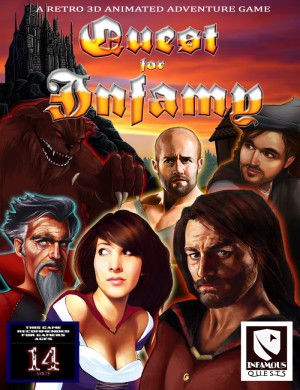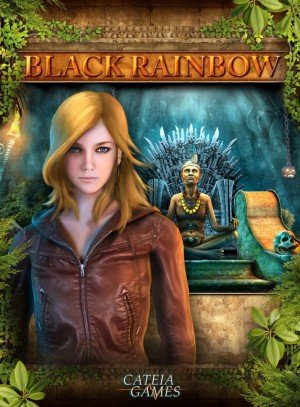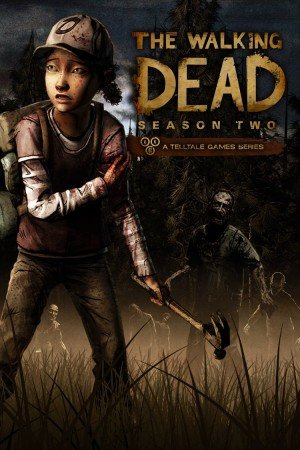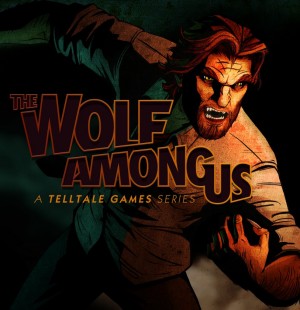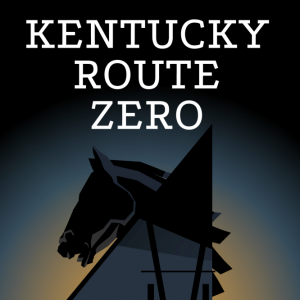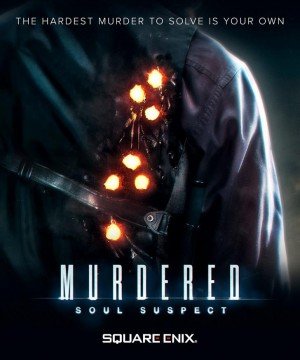Review for Quest for Infamy
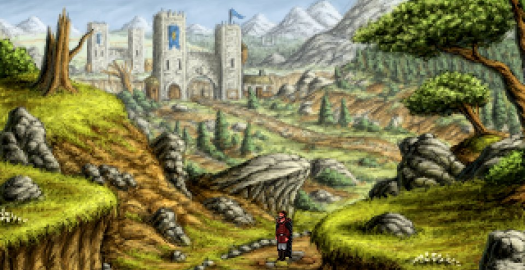
The Quest for Glory series pretty much established the adventure-RPG hybrid singlehandedly back in the late ‘80s and early ‘90s. It did so by borrowing many of Sierra’s design trademarks, but also adding huge worlds filled with dozens of screens, character classes and skills, combat, and day-night cycles on top of that. It’s a beloved series, and yet remarkably, until recently it was practically the only member of the sub-genre it formed.
Lately, however, we’ve been treated to a sudden, unexpected revival of the QFG formula. First to the punch was the outstanding freeware adventure Heroine’s Quest, and now comes the first commercial offering, Quest for Infamy. It is not a remake, but rather a combination of part-clone, part-satire, and mostly faithful homage. The result is both admirable and perplexing. It follows the checklist very closely, which is exactly what QFG fans want, but the delivery in some key aspects, despite its best intentions, can be a little shoddy.
The story follows Roehm, a ladies' man rascal who ends up in the town of Volksville after escaping the rage of a Baron whose daughter he slept with. This amusing intro pretty much sets the tone for the rest of the game. As the title suggests, you are no hero in this game, but rather an anti-hero, if not a particularly notorious one. You assume control within the town gates following a welcome by the bizarre but friendly trader Udo, your first encounter with some of the atrocious voice acting that plagues the game.
The main plot that unfolds in the Kingdom of Lonaria is quite engrossing. Roehm’s arrival coincides with a series of events involving the death of a family cursed by a powerful jewel. Roehm is presented with the quest of recovering it on the basis of having no scruples: in other words, having such low morals and a general lack of respect that he can do whatever is required. The perfect quality for the protagonist of an adventure game.
And boy, does his quest require him to perform all kinds of tasks. Early on, after the events of the first day that include witnessing the execution of an alleged criminal in the town square, you have to choose a path by talking to one of three key characters in town. You can pick the path of the Sorcerer, the Rogue or the Brigand. Each requires you to solve an initial minigame like a drinking game for the Rogue’s path or a card-matching game for the Sorcerer, but once it’s done, it’s done. You can’t change paths after that.
In familiar Sierra style, you’ll right-click or use the mouse wheel or keyboard shortcuts to swap between the different types of interactions: walk, use, talk, look and attack. Each command is represented by its own cursor. You can then left-click a hotspot to execute the corresponding action on it. You can also use keyboard shortcuts to change your movement mode between normal walking, sneaking to pass by undetected in certain areas, or running to move more quickly around the screen. Moving the cursor to the top edge of the screen reveals a menu that displays these same interactions and movement options, but it also has buttons to check your inventory, character stats, a menu with the time of day, a book of magic spells, and a help screen that details the different shortcuts and the meaning of the icons.
Soon after you choose your path, you’ll have your first quest, and as you’ll learn from this initial enterprise, there’s a pretty even mix of inventory-based puzzles, combat and character skill (spells or stealth) development. In all three paths you’ll be required to defeat a beast, though what you must retrieve from the body afterwards and the manner in which you do it depends largely on the class you’ve chosen. You’ll have to collect different items and maybe even sneak past certain characters in order to succeed, depending on your chosen class.
While there are some side quests exclusive to each class, the main quests throughout the game are similarly variations of the same tasks that can be solved differently. Many other activities depend on skills that you can level up through repeated use. For example, at one point you have to descend a waterfall and get something from a gnoll that lurks beneath. You can use equipment and skills to get down, then barter with him to get the item. Or if you’re a Sorcerer, you can float down using your magic and then use another spell to… erm, persuade him.
Similarly, in other situations you can open a lock through lockpicking if you’re a Rogue, or with a special spell if you’re a Sorcerer. As a Brigand, you’ll be better prepared to tank your way into more inaccessible areas. Or maybe you’ll just climb your way out of the city. Classes share basic skills, but there are opportunities that are only available to certain paths. Such diversity is a bonus that still feels thrilling in a point-and-click adventure, adding a whole different layer of immersion.
Regardless of class, I found the puzzles to be well-conceived and generally very logical. Common sense seemed to work most of the time, and the game does a good job of giving you enough hints and guiding you towards your next objective, so you shouldn’t get lost. In fact the solutions may be too easy. Despite how different the approach may be between paths, the game is very rigid when considering alternative solutions and you may end up finding the low difficulty curve off-putting.
The RPG side of things suffers from some of the bad habits of the adventure genre. Just as in many other games where sometimes you get a resonant “no” whenever you try an item combination you deem perfectly logical, so Quest for Infamy simply refuses to let you use many characters' skills outside the specific scenarios it prescribes, no matter how reasonable it seems. Most likely, you were overthinking it and you have to simplify your strategy, which is fine if only you were told what’s wrong. QFG at least bothered more often to come up with plausible and creative reasons, thus feeling less lazy. I get that there are way too many variables to make every possible skill responsive to every possible element, but at least giving a sensible explanation to these limitations would reduce a lot of the frustration.
Fighting is inevitable for some quests, but random encounters can be avoided. Periodically, particularly in common traveller’s areas, enemies will already be “hiding” in a scene as you enter (pretty badly, like a two-year-old child playing hide-and-seek), and if you stay too long in that location, they will attack. So if you see a goblin behind a tree and you’re out of potions, start clicking to get yourself to the next screen, as it won't follow you in pursuit.
Combat scenes show a side view of the battle, and it’s pretty straightforward. You have three different types of attack that you can choose at the bottom of the screen: hacking, stabbing and slashing, each corresponding to a skill of the same name. Enemies are weaker against certain attacks than others, and it’s up to you to figure it out, either by trial and error or asking around among other characters who are experts on the subject – living bestiaries, basically. The more you use “stabbing”, for example, your “stabbing” skill goes up and becomes more effective.
As a Sorcerer, you can also select any of your combat spells from the bottom right corner as many times as you want, but they have a cool down period between uses. As with attack types, each monster is more vulnerable to certain spells than others, like Icy Shards or Flaming Vengeance. There are a few other spells with additional effects like damage over a long period, or an extra opportunity to attack. Unlike attack skills, however, each combat spell is not a skill in itself. Instead they all fall under the umbrella of “Mystical Power”, which is the stat that will raise the more you cast magic.
Combat time is active, meaning that if you delay choosing an action like attacking, casting a spell, or blocking (another skill), the monsters will go ahead and attack you. This makes combat less leisurely than turn-based, but it’s rarely very difficult. It’s fairly easy to buy potions, so as long as you have some with you (or healing spells), you should be okay. Sorcerers are the weakest in battle but represent the only class with access to spells that are useful both in and out of combat. Brigands, as you can imagine, are the toughest and best in battle.
While combat often isn’t mandatory, I found it to be one of the quickest ways to make money in the game, which is needed to buy items you’ll definitely require to solve certain quests, along with potions and other survival items. But there are other ways to make money, like pickpocketing, so how much fighting you do is very much up to you. If you’re really into grinding for money or stats, I would say that at least 15% to 30% of the game can be devoted to combat.
Unfortunately, much like its spiritual predecessor, all this combat is very bland and not particularly well executed. There’s very little strategy needed, and I soon found myself going through a clickfest as a Sorcerer, just pressing the same attacks for long periods with every enemy I encountered (unless a message popped up saying it was completely ineffective). Sometimes I hardly bothered to use my spells, which had no consequence other than making the skirmishes a little longer. These battles really needed some kind of additional depth to make them more entertaining. At least they add a feeling of peril as you venture into new or dangerous areas, and it is satisfying to see your character grow into a badass, both inside and out of combat.
As time passes, your reputation precedes you throughout Lonaria. As you travel to other places such as Tyr, the city of arts and intellectuals (whom everybody else just sees as obnoxious hipsters), you’ll discover a lot of townsfolk already know about you. This is especially true during the first in-game days. Some of your early deeds will reach the ears of NPCs, like defeating an annoying thug that was universally hated. It's rare to find this in an adventure game, and it made me feel that the kingdom was a living, breathing place where my actions mattered. It’s not quite the level of, say… the RPG Skyrim, of course, but finding that everyone from the blacksmith to a hermit far from town had something to say about my exploits was a pleasant surprise. This is, after all, a massive game.
Most of the humour comes from the narrator, who is constantly throwing in sarcastic remarks or joking about whatever happens to Roehm. He is also the inner voice of Roehm, judging your actions and saying what he sees and thinks. This is another shout-out to a memorable feature of the QFG series, especially the spectacular Shadows of Darkness, with its voiced narration by actor John Rhys-Davies. Unlike QFG4 though, the narrator in Infamy is far raunchier and much more juvenile, offering a pastiche of toilet humour and sex jokes that feels pretty sad.
Not surprisingly, almost every significant female character is portrayed with a huge chest and revealing cleavage no matter how impractical or out-of-context this may be for her role. Voleris, the head of the guard in Tyr and a brave fighter raised by a librarian, is depicted wearing a bikini, gratuitously contributing to the tiresome sexual innuendo. You could dismiss this as just part of the humor of the game, but this is no Leisure Suit Larry and it’s not in line with the rest of the writing and setting, which is actually pretty good.
Whenever the game is not objectifying women or forcing British expressions (I cringe whenever the narrator says bollocks) the banter between characters is solid and amusing. Roehm is mostly interested in his own welfare, but he isn’t unlikeable at all. He rarely takes any task, no matter how threatening it is, very seriously. Some lose their patience with him as he insists on making a joke out of everything and others just go along, but either way his witty conversations tend to be hilarious. Not even Rayford, the head of law enforcement in Volksville, is immune to Roehm’s sarcasm.
If the retro pixel art style of Quest for Infamy is not your thing, there’s not much to do about it. But I found it to be a beautiful game with so much to see in a staggering diversity of landscapes. There’s tons of forest scenery, but there’s also the eerie ruins of the cursed Killington manor, the classical architecture of the white city of Tyr, and the labyrinthine Dwarven mines to the south. I truly enjoyed soaking in the sights, and I can’t begin to fathom the amount of effort involved in creating so many locations. Characters are not as detailed and are usually animated using just a couple of frames, but this is an acceptable trade-off for having so many of them around. There are always guardians on patrol or townspeople doing their thing during different times of the day. It’s a great sight that will fill you with nostalgia for the old Sierra games, which is probably what most players are looking for from this game.
I can also speak highly of the soundtrack, which is similarly composed to appeal to longtime adventure fans and has a cinematic quality that rivals some of the best oldies. Mighty drums, melodic flutes, whimsical harp melodies – the score ranges from the epic, imposing theme song of Tyr to the jolly tunes of the pub, to the peaceful sounds of the woods. Atmospheric effects are also lovely and do a fantastic job of immersing you in each scene. Waterfalls, birds, blacksmiths, fountains… it’s all very well done. I wished at times that there were crowd noises in town to accompany everything else, but I honestly didn’t notice they were missing until I was several hours in the game. Other sounds, like those that occur during combat, are hit-and-miss. The attacking sounds seem pretty fake and repetitive, but this is nothing serious.
Voice acting, however, is a train wreck. Thankfully, the protagonist is one of the very few exceptions, but much of the cast sounds like a bunch of friends were asked to do the voices and were invited over to an improvised sound studio in someone’s house. There’s a lot of weird echo, the actors sound untrained, delivering bland or exaggerated performances, and there’s a large mix of accents that don’t make sense within the world’s culture. This is a pretty major criticism, because the game is fully voiced. Every character in the game with lines has a voice actor – a fact I would otherwise be praising unequivocally. The worst offender is Roger, a painter from Tyr, who has one of the most detestable voices I’ve heard in a long time. The closest approximation I can come up with is a medieval Texan creep, but even that description doesn’t fully capture it. Most of the acting is not as gloriously bad as Roger, but it still is uneven and out of place.
Creating a game that uses a blueprint of one of the most ambitious and adored gaming series from the '80s and ‘90s is always a daring proposal. I respect Quest for Infamy for that, and in many ways it succeeds in its goals. It offers a huge, living world to explore, it’s very pretty, has great music, and it maintains interest most of the time thanks to its strong conversations and mysterious plot. But the skills implementation, puzzles and combat are generally just okay, falling short in comparison to their decades-old inspiration. And when it strives to establish its own spirit through humour, it diminishes the whole homage endeavour with juvenile jokes that feel tacky and amateurish – an impression compounded by consistently poor voice acting. For the most part, Infamy’s story seems to take itself fairly seriously, and it works better when it does.
Even with these criticisms, Quest for Infamy is still a rather enjoyable experience overall that will provide you probably with around 15 hours of gameplay on a single playthrough, with replay opportunities for the other two character classes beyond that. For better or worse (depending on your perspective), it’s unapologetically old school, and Quest for Glory fans should find it a welcome return to adventure-RPG hybrid territory that does justice to its famous forebear without ever surpassing it. As a debut offering, this game still has a lot of room for improvement, but it’s certainly on the right track, so here’s hoping that this is just the foundation for a potentially great series to come.
WHERE CAN I DOWNLOAD Quest for Infamy
Quest for Infamy is available at:
- GOG -79%
- Itch.io
- HumbleBundle
- Amazon




